Unlock the captivating history of Pompeii on a small group tour led by an expert archaeologist. Explore the preserved streets and cultural heritage of this ancient Roman city, exploring significant sites like the Temple of Apollo and the House of the Vettii. With skip-the-line access and a focus on intimate exploration, this two-hour journey promises an enriching experience that transports you back in time. Discover the insights that await as you uncover the daily life and fascinating stories of Pompeii.
Key Points
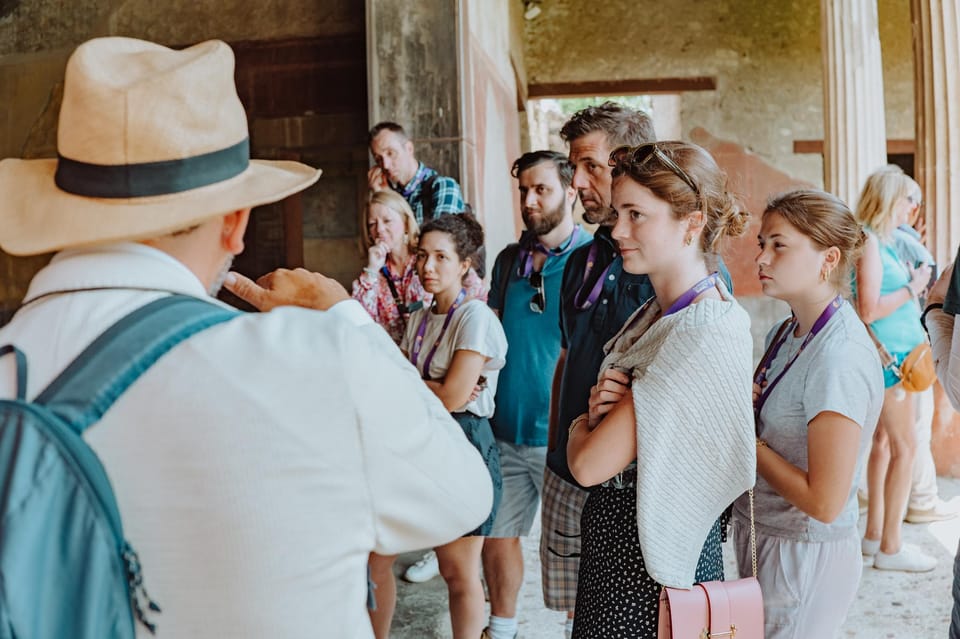
- Small group tour of Pompeii with a maximum of 15 participants, led by an expert archaeologist.
- Includes skip-the-line tickets and a 2-hour guided exploration of major sites like the Temple of Apollo and the House of the Vettii.
- Provides insights into Pompeii’s history, daily life, cultural practices, and the impact of the Mount Vesuvius eruption.
- Offers an immersive experience to wander through the preserved streets, mosaics, villas, and amphitheater of the ancient Roman city.
- Flexible booking options with a "reserve now & pay later" policy and free cancellation up to 24 hours in advance.
Tour Overview
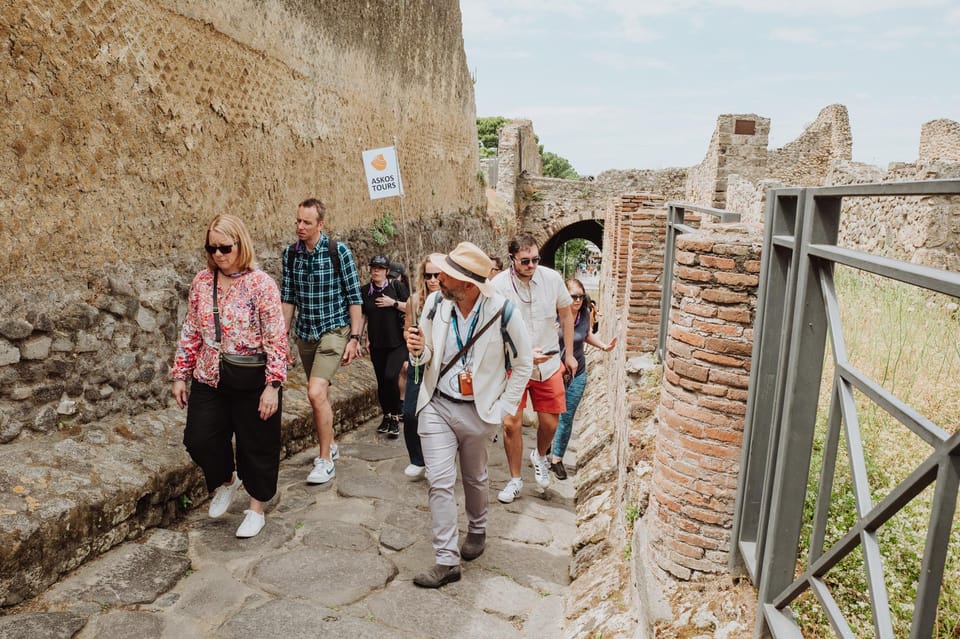
The Pompeii small group tour offers visitors an intimate exploration of the ancient city with the guidance of an expert archaeologist.
The tour lasts 2 hours and accommodates a maximum of 15 people, providing a personalized experience. Priced at $69.46 per person, the tour includes skip-the-line tickets and the services of a knowledgeable archaeologist.
Highlights of the itinerary include visits to the Temple of Apollo, the Foro Civile di Pompei, the Temple of Jupiter, the Basilica, the House of Menander, the Forum Baths, the Lupanare, the House of the Faun, the Large Theatre, and the House of the Vettii, before concluding at the Teatro Grande.
You can also read our reviews of more tours and experiences in Pompei Campania.
Booking Information

How does the booking process work for this Pompeii small group tour?
Travellers can reserve their spot without having to immediately pay. This "reserve now & pay later" option allows flexibility in planning.
On top of that, the tour offers free cancellation up to 24 hours in advance for a full refund, providing peace of mind.
Visitors can check availability and select from various starting times to suit their schedules.
Itinerary Highlights
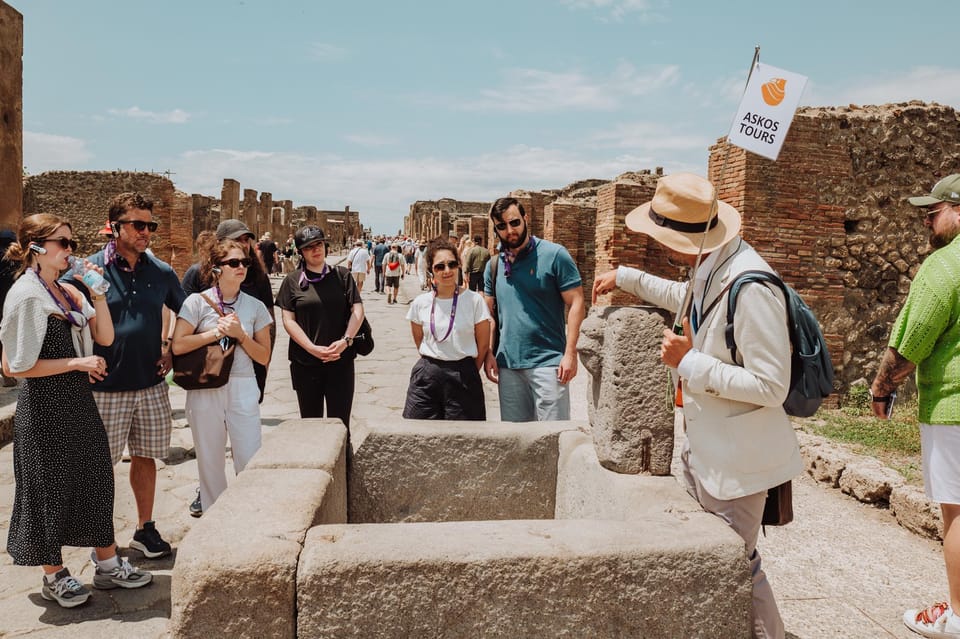
The Pompeii small group tour commences at the Porta Marina Superiore entrance, where staff members holding ASKOS TOURS signs will greet visitors.
The tour takes guests through a carefully curated itinerary, showcasing the city’s most significant historical sites. Highlights include the Temple of Apollo, the Foro Civile di Pompei, the Temple of Jupiter, the Basilica, the House of Menander, the Forum Baths, the Lupanare, the House of the Faun, the Large Theatre, and the House of the Vettii.
Throughout the tour, the expert archaeologist guide provides invaluable insights into the daily lives, cultural practices, and the tragic eruption of Mount Vesuvius in 79 AD that destroyed the city.
Temple of Apollo
Situated prominently within the ancient city, the Temple of Apollo stands as a testament to the religious and civic significance of this revered deity in Pompeian society.
The impressive structure, dating back to the 6th century BC, was a focal point of the city’s cultural and spiritual life.
Visitors can marvel at the well-preserved columns and remnants of the temple’s once-grand interior, which would have been adorned with intricate statues and decorations.
Through this landmark, the tour provides a window into the religious practices and beliefs that were integral to the daily lives of Pompeii’s inhabitants before the catastrophic eruption.
More Great Tours NearbyForo Civile Di Pompei
As visitors make their way through the ancient ruins of Pompeii, they are greeted by the impressive sight of the Foro Civile di Pompei, the city’s civic and commercial center. This sprawling plaza was the heart of public life, hosting temples, government buildings, and bustling markets. Exploring the Foro Civile, visitors can marvel at the well-preserved columns, arches, and foundations that once supported grand structures. The following table highlights some of the key features and highlights of this important archaeological site:
| Feature | Significance |
| — | — |
| Temple of Jupiter | Largest temple in Pompeii, dedicated to the chief Roman god |
| Basilica | Served as a courthouse and meeting hall for city officials |
| Curia | Housed the city council chambers |
| Macellum | Ancient marketplace where goods were bought and sold |
Temple of Jupiter
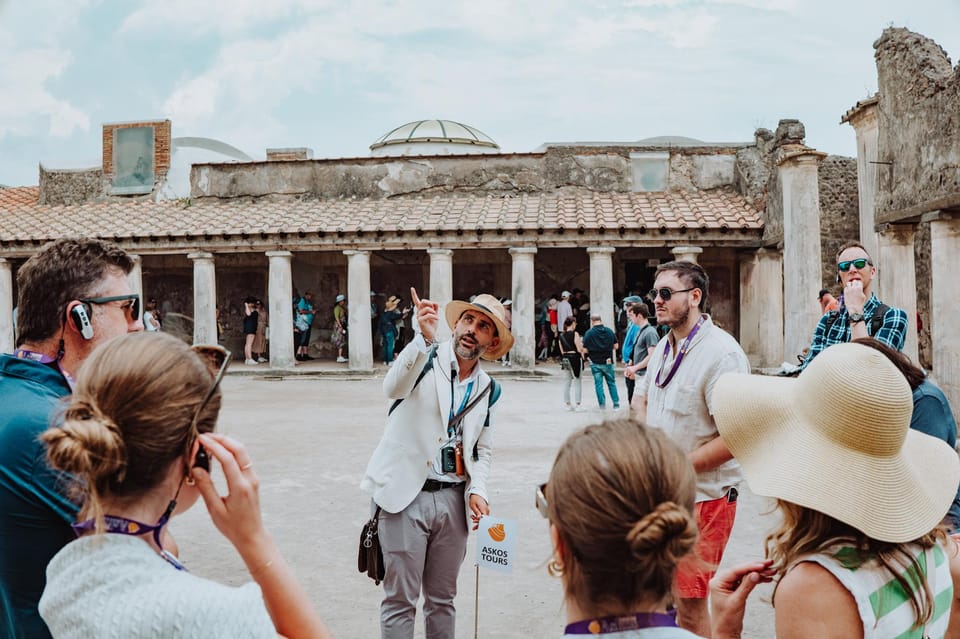
Towering at the far end of the Foro Civile di Pompei stands the majestic Temple of Jupiter, the largest religious structure in the ancient city.
This grand temple was dedicated to the supreme deity of the Roman pantheon and was a central hub of religious and civic life in Pompeii.
Visitors can marvel at its:
-
Impressive scale and architectural grandeur
-
Ornate decorations, including intricate carvings and marble columns
-
Remnants of the original statues and altars that once adorned the interior
-
Panoramic views of the surrounding ruins and the imposing Mount Vesuvius in the distance
-
Insights into the religious practices and beliefs of ancient Pompeians.
Basilica, Pompeii
Dominating the northern side of the Foro Civile di Pompei, the Basilica stands as a testament to the grandeur of Pompeii’s civic and commercial life.
This imposing structure served as a courthouse and meeting hall for the city’s elite. Visitors can admire the intricate marble columns and ornate decorations that adorned the interior.
The Basilica’s impressive size and strategic location highlight its importance as a hub of political and economic activity in ancient Pompeii.
The Basilica’s imposing scale and central positioning underscore its pivotal role in Pompeii’s political and commercial landscape.
Exploring this well-preserved site offers a glimpse into the vibrant commercial and judicial heart of the doomed city.
House of Menander
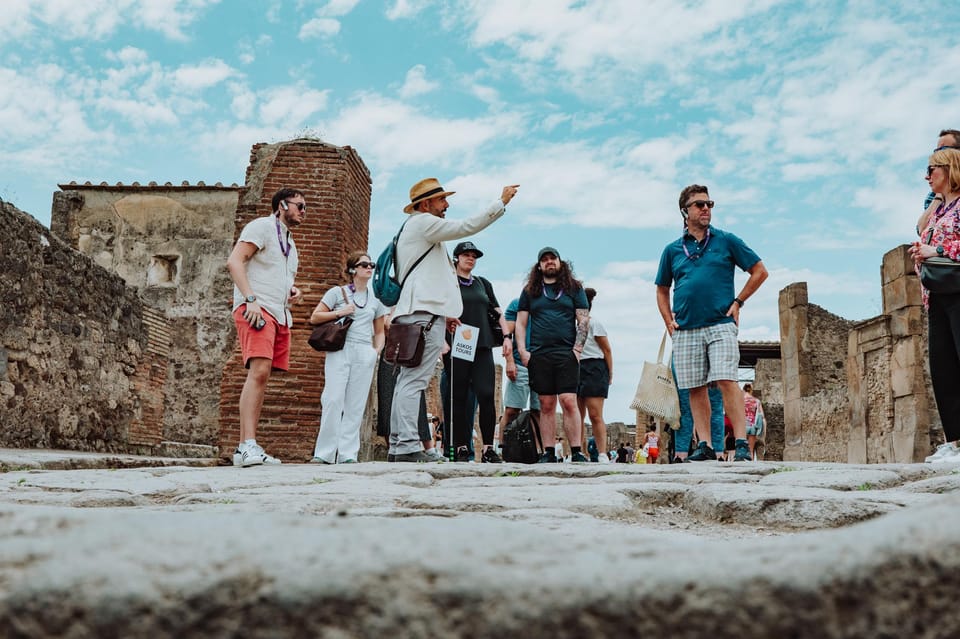
The House of Menander, located within the ancient city of Pompeii, stands as a remarkable example of the affluence and cultural sophistication of its former inhabitants.
This well-preserved domus, or private residence, offers a glimpse into the daily lives of the upper-class Pompeiians:
-
Expansive atrium and peristyle gardens that showcased the owner’s wealth and status
-
Intricate mosaics and frescoes adorning the walls, floors, and ceilings
-
Thermopolium, or fast-food counter, indicating the presence of commercial activities within the household
-
Elaborate wall paintings depicting mythological scenes and daily life
-
Remarkably intact architectural elements, including the remains of a second story
Forum Baths, Pompeii
Located adjacent to the bustling Forum of Pompeii, the Forum Baths stand as a testament to the city’s dedication to public amenities and leisure.
The expansive bathing complex held separate areas for men and women, each with their own caldarium (hot room), tepidarium (warm room), and frigidarium (cold room). Visitors would have moved through these rooms, indulging in the social rituals of Roman bathing culture.
The baths also featured a gymnasium and palestra, where citizens could exercise, socialize, and engage in intellectual discourse.
The remarkably well-preserved ruins offer a glimpse into the daily lives of ancient Pompeians.
Lupanare
Perched atop the highest point of the ancient city, the Lupanare, or brothel, stands as a notorious landmark in Pompeii.
This two-story structure features:
-
Frescoed walls depicting explicit sexual scenes
-
Beds made of stone and wooden benches for customers
-
Private rooms on the upper level for discreet encounters
-
Distinctive architectural design with an open courtyard
-
Symbols and graffiti alluding to the commercial nature of the hotel
The Lupanare offers a glimpse into the complex social dynamics and personal lives of Pompeii’s inhabitants, shedding light on the city’s vibrant, yet sometimes salacious, culture.
House of the Faun
Occupying a prominent position in the heart of Pompeii, the House of the Faun stands as a testament to the grandeur and sophistication of the ancient city.
This sprawling villa was named after the bronze statue of a dancing faun discovered on the premises. With its lavish mosaic floors, ornate frescoes, and extensive gardens, the House of the Faun exemplified the wealth and cultural refinement of its aristocratic owners.
Visitors can marvel at the intricate designs and imagine the opulent lifestyle that once thrived within these walls, offering a glimpse into the daily lives of Pompeii’s elite before the catastrophic eruption of Mount Vesuvius.
Large Theatre, Pompeii
As visitors make their way through the sprawling ruins of Pompeii, they are greeted by the imposing presence of the Large Theatre, a testament to the city’s rich cultural heritage.
This grand structure, capable of seating up to 5,000 spectators, would have hosted a variety of performances, from theatrical productions to gladiatorial contests. The theatre’s remarkable acoustics and intricate architectural features showcase the advanced engineering skills of Pompeii’s inhabitants.
Key highlights of the Large Theatre include:
-
The stage, which was adorned with elaborate marble decorations
-
The orchestra pit, where musicians would have performed
-
The seating areas, divided into different sections based on social status
-
The backstage area, where actors and performers prepared for their shows
-
The overall scale and grandeur of the structure, a true marvel of ancient Roman engineering.
House of the Vettii
The House of the Vettii stands as a testament to the opulence and sophistication of Pompeii’s elite. This well-preserved villa was once home to two wealthy brothers, Aulus Vettius Conviva and Aulus Vettius Restitutus.
The intricate frescoes and mosaics adorning the walls and floors showcase the owners’ refined taste and affluence. Visitors can admire the remarkable details, including the mythological scenes and erotic imagery that were common in the homes of the upper class.
The House of the Vettii offers a glimpse into the luxurious lifestyles of Pompeii’s prosperous citizens before the devastating eruption of Mount Vesuvius.
Tour Concludes at Teatro Grande
After exploring the remarkable House of the Vettii, the tour concludes at the Teatro Grande, the grand theater of Pompeii.
The Teatro Grande, capable of seating over 5,000 people, stands as a testament to the city’s cultural prominence.
The tour guide shares insights about:
-
The theater’s impressive architectural design and acoustics
-
Its role as a hub for entertainment, cultural events, and civic gatherings
-
The intricate carvings and frescoes that once adorned the interior
-
How the theater was destroyed in the eruption of Mount Vesuvius in 79 AD
-
The ongoing excavation and preservation efforts to uncover its rich history.
Tour Experience
Embarking on this small group tour, visitors are treated to an intimate exploration of Pompeii’s history and culture, guided by an expert archaeologist.
Through the archaeologist’s insights, guests gain a deeper understanding of the daily lives, cultural practices, and the fateful eruption of Mount Vesuvius in 79 AD that devastated the city.
Wandering the remarkably preserved streets, mosaics, villas, and amphitheater, the group discovers the remarkable state of preservation of Pompeii, a UNESCO World Heritage site.
The tour provides an immersive experience, transporting visitors back in time to witness the glory and tragedy of this ancient Roman city.
Ask Away
Is There a Restroom Available During the Tour?
The tour overview does not explicitly mention the availability of restrooms during the tour. However, as this is a guided visit of the archaeological site of Pompeii, it is likely that restroom facilities would be accessible to tour participants at various points throughout the itinerary.
Can We Bring Our Own Food and Drinks?
According to the tour overview, there is no mention of being able to bring your own food and drinks. It is recommended to check with the tour operator for any policies regarding outside food and beverages during the tour.
How Much Time Is Allocated for Each Site Visit?
The tour itinerary focuses on exploring key sites in Pompeii, allowing visitors an opportunity to discover the ancient city’s history and culture. While specific time allocations are not provided, the guided visits are designed to provide an immersive experience within the 2-hour duration.
Is There Any Audio Equipment Provided for the Tour?
The tour does not mention providing any audio equipment, such as headphones or earpieces, to participants. The focus appears to be on an intimate small group experience with an expert archaeologist guide providing in-person commentary and insights during the tour.
Are There Any Discounts Available for Students or Seniors?
The tour provider does not explicitly mention any discounts for students or seniors. However, it’s best to inquire directly with them about any potential discounted pricing options that may be available, as these can vary.
Final Words
This small group tour offers an immersive and enriching exploration of Pompeii’s captivating history. Led by an expert archaeologist, the tour provides skip-the-line access to significant sites, allowing visitors to explore the daily lives of ancient Romans. With a focus on intimate discovery and insights, the tour promises a memorable journey through the preserved streets and cultural heritage of this remarkable archaeological site.
You can check availability for your dates here:More Tours in Pompei Campania
More Tour Reviews in Pompei Campania
Not for you? Here's more nearby things to do in Pompei Campania we have reviewed
- Pompei: Vesuvius and Herculaneum Tour
- Pompeii-Herculaneum and Vesuvius Full-Day Tour
- Naples: Private Pompeii Tour with Guide and Transfer
- Pompeii Tour with Maxi Mall Shopping Experience
- Pompeii and Vesuvius Cellars: Tour with Pick-Up in Positano
- Pompeii Ruins: Guided Tour from Positano
- Pompeii in 2h and 30mnt: walk with local guide
- Pompeii: Guided Tour and Lunch
- From Salerno and Amalfi: Pompeii Guided Tour with Transfers
- Pompeii: Skip The Line Entrance Tickets + Audioguides
- Wine Tasting on Mt. Vesuvius
- From Pompeii: Mount Vesuvius Hike & Tour by Bus
